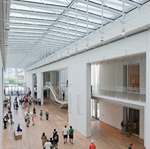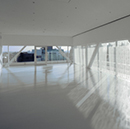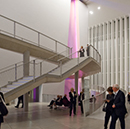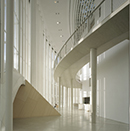
White Box
White Box, an undecorated space with white walls, white ceiling and a continuous neutral floor, originated in 1927 as clean envelope, a bare white architecture. An influential 1930 MoMA exhibition secured it as a museum aesthetic. more
White Box | Museum
application
The White Box, the dominant twentieth-century practice regarding art museum interior design and architecture, makes objects untouchable and exclusive by displaying collections on a null white wall as a neutral canvas.
research
White Box draws from Brian O'Doherty's critical essay Inside the White Cube: The Ideology of the Gallery Space (1976). O'Doherty argues that galleries' antiseptic white walls helped to determine the meaning of modern art as much as the artworks themselves. He characterizes the "white cube" is a kind of non-space, ultra space, or ideal space where the surrounding matrix of space-time is symbolically annulled. In Contemporary Cultures of Display, Emma Barker also names a white cube as a typical practice of museums, galleries and exhibition spaces for displaying contemporary art. She defines the space as simple and undecorated with white walls and a polished wood floor or soft gray carpet. In 2004 Joori Suh's thesis, "Theory Studies: Contemporary Museum and Exhibition Spaces," traced the practice from its use in the 1930s by the Museum of Modern Art as a perfect environment for the undisturbed presentation of art to the use of the white cube internationally. The white cube evolved from museum settings and can more accurately be described as White Box, found first in modern house designs, and in additional practice types, such as retail stores and boutique hotels.
bibliographic citations
1) The Interior Archetypes Research and Teaching Project, Cornell University, www.intypes.cornell.edu (accessed month & date, year).
2) Suh, Joori. “Theory Studies: Contemporary Museum and Exhibition Spaces.” M.A. Thesis, Cornell University, 2003, 94-98.






